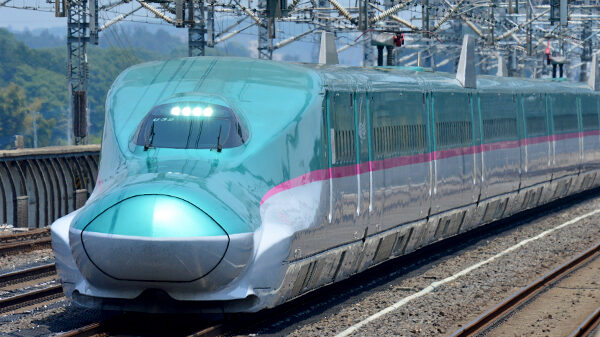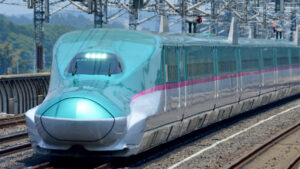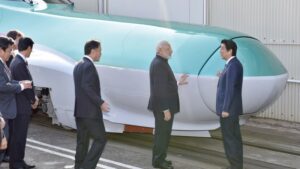A Grand Design for the Expansion of the Shinkansen outstanding technology the World

(IISIA Researcher’s Report)
What comes to mind when you hear the word “Japan”? Some people might say her beautiful nature and traditional culture as well, and others might say cartoon films. However, regarding outstanding technology, the most distinctive element of Japan is supposed to be “Shinkansen (bullet train)”.
(figure: JR East E5 series shinkansen)

(source: Wikipedia)
Since its service launched in 1964, the Shinkansen has served as a secure foundation for the Japanese society offering comfort and safety of the passengers. Everyone who comes to Japan could receive much benefit from it.
However, it is often pointed out that the unique railway system of Shinkansen is less accepted in the global market than expected. So far, the only example in which the technology developed for Shinkansen, was exported, is Taiwan’s High Speed Rail. Why has the Shinkansen, which is supposed to enjoy good reputation worldwide, fallen into such a situation? While there are numerous possible causes, the most significant reason could be its “technological peculiarity.”
The Tokaido Shinkansen, which runs between Tokyo and Shin-Osaka, is the most symbolic line of the Shinkansen and puts nearly 400 trains into service a day. It is an astounding number compared to similar high speed railway systems in other countries. Moreover, those who operate the Shinkansen make tremendous efforts to maintain punctuality, which is said to be one of the most reliable railway world. In addition, the car body of Shinkansen has been developed with a number of innovations, including its a unique structure designed to reduce the air resistance as much as possible, as well as the design that enables passengers to feel comfortable These innovations are closely related with the assumption that Shinkansen trains will not cause accidents. However, in other countries, such “Japan-specific” designs could provide a disadvantage.
First of all, the high cost hinders from accepting the shinkansen system’s technology innovations. The more innovations are applied, the higher cost could be. Because its technology products are generally very expensive, the Shinkansen system is often unprofitable abroad. No matter how good the Shinkansen’s design is, it is far tolerable for European railway company to import the shinkansen system. In addition, the high-speed rail systems designed and operated by France and Germany have the different rolling stock standards from those in Japan, which are called “European standards,” so if you want to introduce the shinkansen system, you have to adapt inevitably it to these European standard which bring out high cost inevitably.
Based on the aforementioned realities, the Japan has to take several measures to execute the export offense for the “Shinkansen system”. In 2011, Japan Consultants Corporation (JIC) was established mainly by the Japanese major railroad companies to promote the international standardization of Japanese railway systems and to establish a comprehensive consulting system to conduct feasibility studies, design, and bidding support from the standpoint of other countries. In FY2018, the “Act on Promotion of Participation of Japanese Companies in Overseas Infrastructure Development Projects (Overseas Infrastructure Development Act)” was enacted to promote overseas projects of Japanese railroads systems with their related businesses., The rolling stock industry generally produces its products on a build-to-order basis for railroads and other companies, and it generally takes several years before their manufacturing process is completed. Furthermore, its design work is said to take one to two years for a typical new project in Japan, while if it takes even several more years for a new project overseas. Therefore, even a slight modification of railroad car bodies used in Japan for the sake of an overseas project, tend to lead the relevant Japanese companies to be procured in terms of price competitiveness.
The Japanese railroad industry to be successful global market, these challenges. Looking around the world, weseethatJapan’s neighbor, China, is recently the proud of its success story in the global railroad industry. How has China succeeded in marketing its technology around the world? In this regard, it has been pointed out that the Chinese railroad companies, which are state-owned enterprises, have been led by the Chinese government to inject capital to increase their production, and that China has provided financial support to other countries suffering from the Euro crisis and used her political power to promote the introduction of Chinese products to these countries in order to increase her influence in the entire European market.
(figure: Prime Minister be visiting a local Shinkansen factory in india with Prime Minister Modi in 2016)

(Source: Ministry of Foreign Affairs of Japan)
The Japan’s “high-performance” but “high-priced” railroad system is facing these global storms. For the Japanese railroad industry of which the character is domestic by nature, it’s awfully difficult to sell the complete package of its product to the global market. In the aforementioned Shinkansen introduction in Taiwan, the car body and other components are Japanese, but the signaling and operation technologies are a “hybrid system” that consists of the mixture with European technologies.
The “Texas Shinkansen,” which is scheduled to open in Texas in 2026, could be an outstanding breakthrough for the Japanese railroad industry, especially in terms of accelerating export of the Shinkansen system. In this regard, the project, which is being undertaken by the Texas Central, a private American company, using Japanese Shinkansen technology, will be supported by the Central Japan Railway Company (JR Tokai), and will basically use the similar Shinkansen system with the original one in Japan. After various direct exchange of views between Japan and U.S. officials, the project was approved unanimously. The most important point is that the “U.S. authority recognizes the Japanese system and even permits to use kilometers instead of miles to indicate speed. In addition, a new standard was also introduced to meet the American standards, called the Rule of Particular Applicability (RPA). This flexibility is what Japan’s export industry misses today, and as a result of these efforts, the Japan’s railroad industry hopes its further success in the global export offence.
Sooner or later, the Japan’s railroad industry as a whole will reach a major turning point. The Japanese rail industry will be faced a similar major turning point in the future as well. Let us see how they will to overcome the problems such as capacity in car body manufacturing and the rules of international standards. The experience of the Texas Shinkansen will be surely a good lesson for the near future.
Hiroto HARIMA
Analyst, Global Intelligence Group (GIG)



